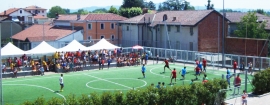After starting and consolidating the Oratory at Valdocco, followed by the first other Turin oratories, and after seeing the Salesian Congregation recognized by the Holy See, Don Bosco found himself in Turin with a problem of "abundance" of devotees and professed. It was necessary to find a separate location, perhaps in the countryside, for the many novices. Attention fell on San Benigno.
The operation's enthusiastic patron was the then parish priest Fr Antonio Benone. He made the proposal to the Saint of the Young, who welcomed him gladly, but left to Fr Benone the task of obtaining the consent also of the then bishop of Ivrea, Msgr. Luigi Moreno, today a candidate for sanctity, but at the time hostile to Don Bosco.
Fr Benone "sure of not encountering any difficulty for such fine work, went to Monsignor, to whom with the familiarity of an old friend he explained the case. "Never, ever," His Excellency said to him, "will I allow Don Bosco to settle in my diocese," state the Biographical Memoirs (MB XIV).
Nevertheless Fr Benone continued to weave his canvas: thus when the cardinal's palace was declared a national monument in 1877, it could no longer be ceded to anyone and the Municipality of San Benigno would have it used exclusively for "uses of public utility". It so happened that the following year Msgr. Davide Riccardi suceeded Msgr Moreno, the former being of a different opinion of Don Bosco.
The municipality granted the building to Don Bosco, establishing a risible rent (one lira) as long as it hosted free schools for the town's young people. Don Bosco obviously could not object to such a request, and he completed and added to it by obtaining permission to host the novitiate there as well.
The Salesians arrived in San Benigno Canavese on 5 July 1879. The First Director of those novices was Fr Giulio Barberis.
The first workshops were soon set up the following autumn for: tailors, carpenters, blacksmiths and bookbinders. Over time there were various transformations, but the house always remained focussed on work and work skills. For several decades there were printers and also an agricultural school at the "Molino". Also at the Molino a rudimentary power plant ensured the whole town's lighting. In 1904 they opened night schools and the festive oratory for weekends and holidays.
In recent times there was an employment center to help young people find and start work. It later became a junior high school and a vocational training center. Today it welcomes about 900 students every day.


